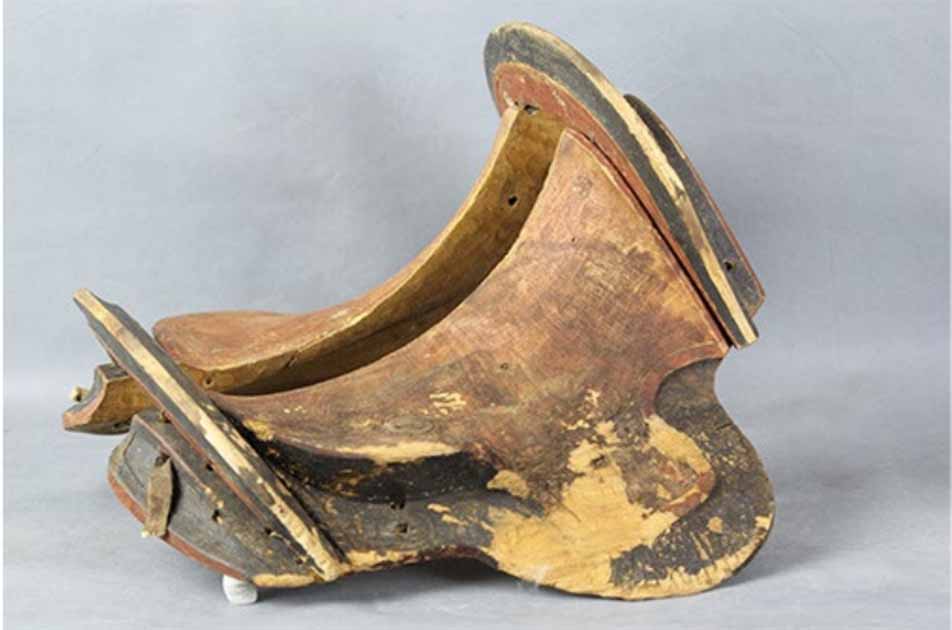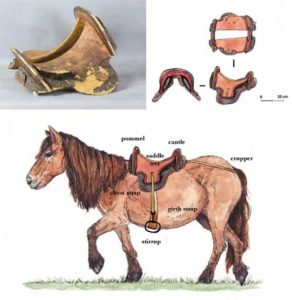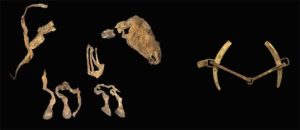The World’s Oldest Wooden Framed Saddle Uncovers Military Horse Technology Secrets

The “oldest saddle of its kind” in the form of a wooden frame with iron stirrups has been found preserved in an ancient tomb in Mongolia. Archaeologists employed radiocarbon dating to analyze the find, placing it between 267–535 AD – the oldest known true wooden frame saddle in East Asia!
The painted saddle had been previously looted from a cave burial. The domestication of modern horses commenced around 2000 BC in Western and Central Asia by the nomadic steppe populaces of the region.
The discovery sheds light on the role of equestrian technology in the ascent of Mongolian steppe cultures. The durability of a wooden-framed saddle on horseback, especially with the incorporation of stirrups, allowed for increased weight-bearing capacity and afforded riders greater control, thereby enabling various forms of mounted combat.
Equestrian Technology and the Development of Warfare
To trace the origins of this revolutionary technology, a collaborative team of archaeologists from institutions across Asia, Europe, and North America studied a saddle discovered in a human and horse burial at the cave of Urd Ulaan Uneet in western Mongolia. Their findings, published in the journal Antiquity, indicate that saddle’s materials were locally sourced.
The leather was derived from domestic horses bred in the region, and the wood was obtained from nearby birch trees. This suggests not only the utilization of this innovative riding technology by horse cultures in the eastern Eurasian steppe but also their active involvement in its development and production. Other contemporaneous discoveries in Mongolia include early metal stirrups.

“Despite their ubiquitous presence within modern equestrian activities, saddles and stirrups were not used during the early cen
turies of horse-back riding”, state the authors. “Their development revolutionized mounted warfare and contributed to far-ranging social change across Eurasia but the origins of this technology remains poorly understood.”
Spectacular Photographs Shed Light on the Ancient Nomadic Lifestyle of Mongolia
Study Unravels the Mysterious Origins of Nomadic Mongolian Empires
Diagram of how the saddle would fit on a horse when complete. (P. Lopez Calle/Antiquity Publications Ltd)
Crucially, the saddle’s dating aligns with the rise of the Rouran Khaganate, a formidable Proto-Mongolic ‘imperial confederation’ that conquered significant portions of Inner Asia. The emergence of new saddle technology facilitating mounted combat likely played a pivotal role in the Khaganate’s success.
Its military victories and subsequent control of Inner Asia may have hinged on the advanced saddle technology, thereby imparting profound implications for our comprehension of East and Central Asian history.

“Mongolian steppe cultures were closely tied to key innovations in equestrianism, an advance that had a major impact on the conduct of medieval warfare,” write the authors.
Timeline of the development of saddle technology in East Asia, showing how the Urd Ulaan Uneet saddle fits in. (W. Taylor/Antiquity Publications Ltd)
The early practice of equestrianism was fundamentally bareback, with riders wielding bows and arrows while maintaining control by gripping the horse with their legs and clutching the animal’s mane. This initial form of mounted travel underwent significant developments over time. Within a few centuries, inhabitants of the northern steppes introduced innovations such as the bridle and bit, marking a crucial advancement in the relationship between riders and their horses, according to a press release.
By approximately 1000 BC, there was a notable shift in riding techniques as horse riders transitioned to mounted riding on a soft pad, enhancing both the comfort of the rider and the control exerted over the horse. These developments in equestrian technology reflect the dynamic evolution of the ancient practices that laid the foundation for modern horseback riding.
“These new improvements to equestrian combat may have contributed to the formation of early steppe polities”, state the authors. “Our findings raise the compelling possibility that the rise of the Rouran was aided by technological supremacy linked to the early use of frame saddles and metal stirrups.”
Finding the Saddle: A Looting, DNA Testing, Gender Politics
In 2015, authorities alerted archaeologists at the National Museum of Mongolia about the looting of a cave burial at Urd Ulaan Uneet near the province of Khovd in western Mongolia. The confiscated artifacts included a birch saddle adorned with black and red paint and equipped with leather straps, an iron bit, wooden archery gear, and the mummified remains of a horse. The bones of a man interred in sheep and badger hide clothing, were also recovered from the tomb, earning it the moniker “cave of the equestrian.”

Horse remains and bridle bit from Urd Ulaan Uneet. (W. Taylor and J. Bayarsaikhan/Antiquity Publications Ltd)
DNA testing confirmed the human remains belonged to a man, while the animal was identified as a male domestic horse. The researchers further conducted radiocarbon dating on the human remains and the leather stirrup strap from the saddle, placing the burial and the associated saddle around the year 420 AD.
The process of domestication had its challenges for horses, as evidenced by the examination of the horse found in the Urd Ulaan Uneet burial. The horse exhibited dental damage likely related to the use of a bit, along with alterations to its nasal bones. Comparable injuries have been observed in other horse burials across Central and Eastern Asia.
Notably, the Urd Ulaan Uneet horse displayed “healed nock marks to the ears,” indicating potential markings that might have been used to signify ownership during its lifetime, according to Taylor, reports Live Science.
Contrary to the common perception that horse riding was primarily a male activity, the “cave of the equestrian” challenges this notion; horse riding was not exclusive to men. Clearly, both men and women of the steppe rode horses.